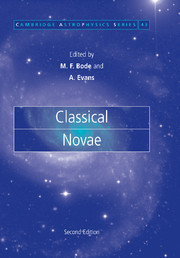Book contents
- Frontmatter
- Contents
- List of contributors
- Preface to the first edition
- Preface to the second edition
- List of symbols
- 1 Novae: an historical perspective
- 2 Properties of novae: an overview
- 3 The evolution of nova-producing binary stars
- 4 Thermonuclear processes
- 5 Nova atmospheres and winds
- 6 Observational mysteries and theoretical challenges for abundance studies
- 7 Radio emission from novae
- 8 Infrared studies of classical novae
- 9 Optical and ultraviolet evolution
- 10 X-ray emission from classical novae in outburst
- 11 Gamma-rays from classical novae
- 12 Resolved nebular remnants
- 13 Dust and molecules in nova environments
- 14 Extragalactic novae
- Object index
- Subject index
10 - X-ray emission from classical novae in outburst
Published online by Cambridge University Press: 10 October 2009
- Frontmatter
- Contents
- List of contributors
- Preface to the first edition
- Preface to the second edition
- List of symbols
- 1 Novae: an historical perspective
- 2 Properties of novae: an overview
- 3 The evolution of nova-producing binary stars
- 4 Thermonuclear processes
- 5 Nova atmospheres and winds
- 6 Observational mysteries and theoretical challenges for abundance studies
- 7 Radio emission from novae
- 8 Infrared studies of classical novae
- 9 Optical and ultraviolet evolution
- 10 X-ray emission from classical novae in outburst
- 11 Gamma-rays from classical novae
- 12 Resolved nebular remnants
- 13 Dust and molecules in nova environments
- 14 Extragalactic novae
- Object index
- Subject index
Summary
Introduction
X-ray observations of novae in outburst have turned out to be a very powerful tool for the study of novae. The X-ray regime is best suited to study the hot phases in a nova outburst. Unfortunately, the present status of our knowledge is still rudimentary, quite different from that of other spectral ranges such as the ultraviolet, visible, or infrared. Few novae have been observed so far in X-rays and essentially all of them lack observations over a complete outburst cycle. In the visible spectral range novae have been systematically observed over more than a century, and in the infrared and ultraviolet many systematic observations which cover the whole outburst cycle have been obtained. So the picture which has emerged from X-ray observations is far less systematic than that from the abovementioned spectral regions (cf. for example Chapters 9 and 8). However, although by no means plentiful, the X-ray observations carried out so far have provided many fundamental and sometimes totally unexpected new results.
GQ Mus was the first classical nova from which X-ray emission was detected during the outburst (Ögelman, Beuermann & Krautter, 1984). In 1984 April GQ Mus was detected at about 460 days after outburst at a 4.5σ level with the low-energy telescope (0.04–2 keV) and the Channel Multiplier Array (CMA) detector aboard EXOSAT.
- Type
- Chapter
- Information
- Classical Novae , pp. 232 - 251Publisher: Cambridge University PressPrint publication year: 2008
- 15
- Cited by



